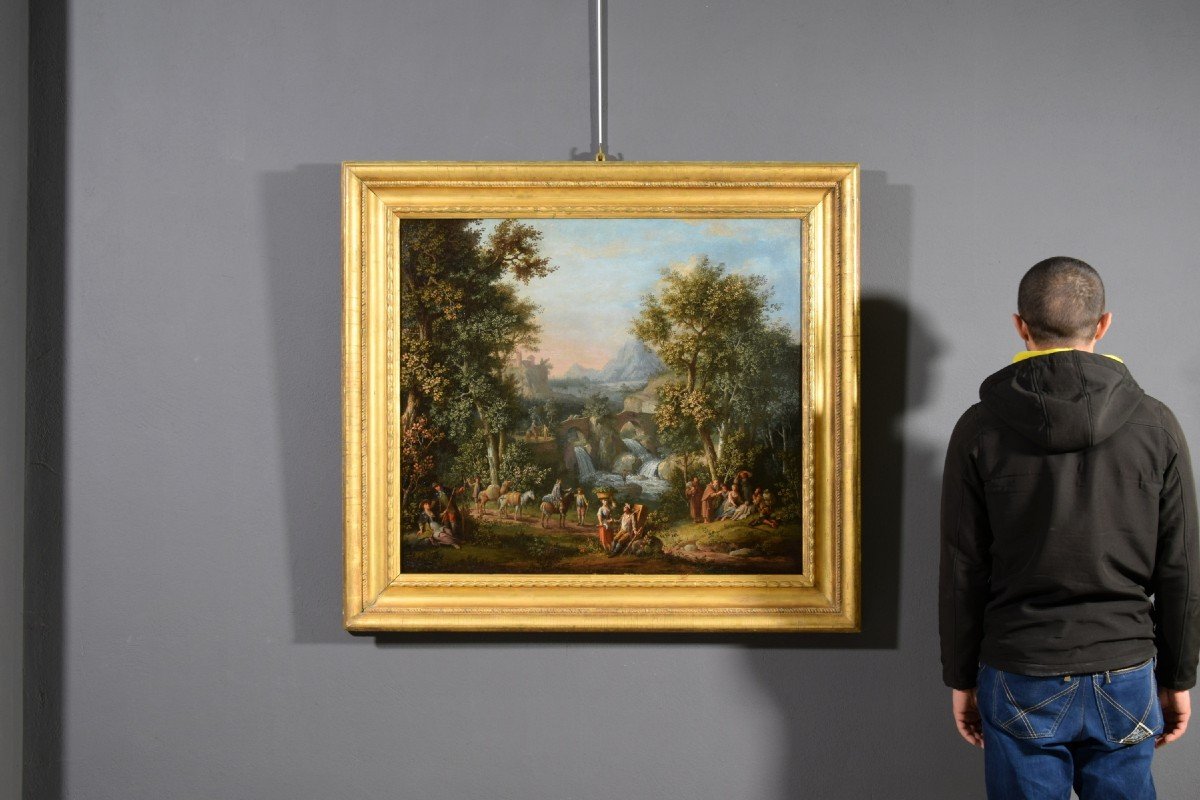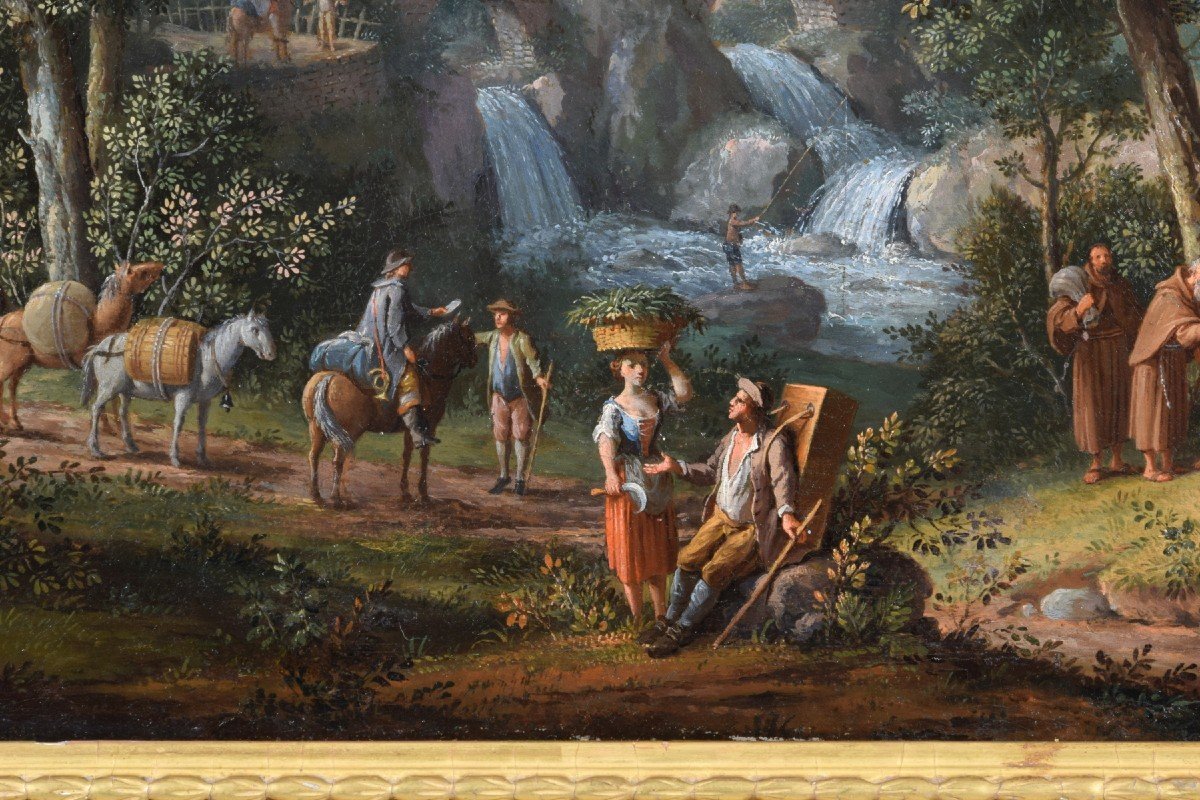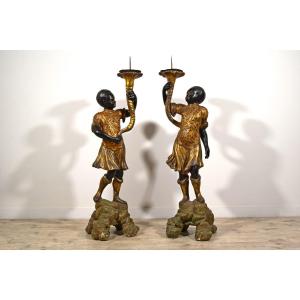Landscape with figures
Oil on canvas, Frame H 102 x L 112 x P 8; canvas H 77 x L 87
The valuable painting, attributable to the painter Giovanni Battista Innocenzo Colomba (1713 - 1793), depicts a wooded landscape animated by characters. At the center of the canvas is a bridge with two arches from which flow lively waterfalls, characteristic of the works of the painter. In addition to the bridge, built of bricks and crossed by some travelers with steeds, the landscape opens, hilly, and then be bordered by large mountains that clear away. A fortress shows a turreted castle overlooking the void. In the foreground, along a path, several people are caught and portrayed in their daily lives. From the left, a couple of travellers take a break, while a few others, accompanied by horses, continue their journey. In the middle two peasants, she with a wicker basket on her head full of wheat and a scythe in her hand, he sitting, with a stick and a pannier on his shoulders, entertain themselves in a dialogue, while on the right two humble parents pray before a child in need of care. The dramatic scene, full of pathos, exalted by the gestures of comfort and concern of two people who flock, are joined by a couple of friars through a gesture of blessing, reminiscent of the power of faith and hope. It is therefore a work of fine workmanship, very pleasant on the aesthetic level and certainly decorative. However, the landscape and the many characters depicted conceal a richer and more vigorous message of faith that the author develops with discretion and descriptive force. In the work is immediately recognizable the style that distinguishes the works of the mature painter, in which the lively and bright palette is accompanied by fine brushstrokes to form landscapes that oscillate between Rococo and Neoclassicism.
Giovanni Battista Innocenzo Colomba (1713 - 1793) was born in Arogno (Canton Ticino), in a family of painters, plasterers and architects whose founder is Andrea Colomba (1567-1627). He learned painting from his uncle, Luca Antonio Colomba, a painter at the Wüttemberg court in Germany, and around 1737 he was an independent painter in Mainz, where he painted several frescoes and decorations. It is probable that he completed his training at the Academy of Vienna, in those years a fundamental centre of aggregation and cultural exchange. He had an intense activity as a set designer and decorator at various princes. In 1741 in Frankfurt he decorated, with squares and allegorical paintings, the ceiling of Römer’s "Imperial Staircase" (destroyed in World War II), on the occasion of celebrations for the coronation as emperor of Charles VII (12 February 1742). In 1748 he was called to Hamburg where he worked in Schleswig-Holstein (large fresco, in the church of Uetersen with Glorification of the Trinity). In Hanover he became court painter to George II. In 1751 he passed into the service of the Duke of Württemberg. In Ludwigsburg and Stuttgart he had an important position for the grand court festivals.
He is a professor at the Stuttgart Academy of Arts founded by Carlo Eugenio in 1761. By 1763 he worked in Italy: on that date the new theatre was inaugurated in Como, in which Colomba worked for many scenes. In the same city he painted the choir of St. James and the church of the seminary Benzi.
The painter moved to Turin where he took the place of the Galliari brothers signing in 1769 the capitulation with the Society of the Knights that administered the Teatro Regio. Relations with the Turin theatre, where he worked for two seasons until 1771, were however studded with endless quarrels. In the years 1774-1780 he is documented in London as a landscape and stage painter at the King’s Theatre and in 1775 he set up a theatre at Weston Hall for Sir Henry Bridgeman. His stay in London allowed him an early opening towards the pre-Romanesque aesthetic, recognizable in the landscapes he made at that time. From 1780 he settled permanently in Arogno and in 1792 he painted in the church of S. Carlo in Poschiavo in Valtellina three canvases with S. Remigio baptizing Clodoveo, S. Rocco between the plague and the Annunciation. In these last works his style oscillates between classicist aesthetics and that still baroque, obviously in tune with the tastes of the client.
According to tradition he died in Arogno in 1793.
The canvas object of this study presents the unmistakable stylistic manner of the artist. The work can be flanked by several paintings signed or returned with certainty to the production of Giovanni Battista Innocenzo Colomba, where we find the same treatment of atmospheric light, the fronds of trees, of the scenographic compositional system and of great depth of perspective. Equally consistent is the color used, particularly recognizable in reds and greens, in browns and blues.
Several elements return, such as the presence of water, of the wide green fronds described with luministic research and of the lively figures portrayed never in static poses but carefully in capturing a precise moment, giving movement and pathos to what is depicted.
We apologize for any translation errors from Italian. Please click expertise to read it in French.


















































 Le Magazine de PROANTIC
Le Magazine de PROANTIC TRÉSORS Magazine
TRÉSORS Magazine Rivista Artiquariato
Rivista Artiquariato